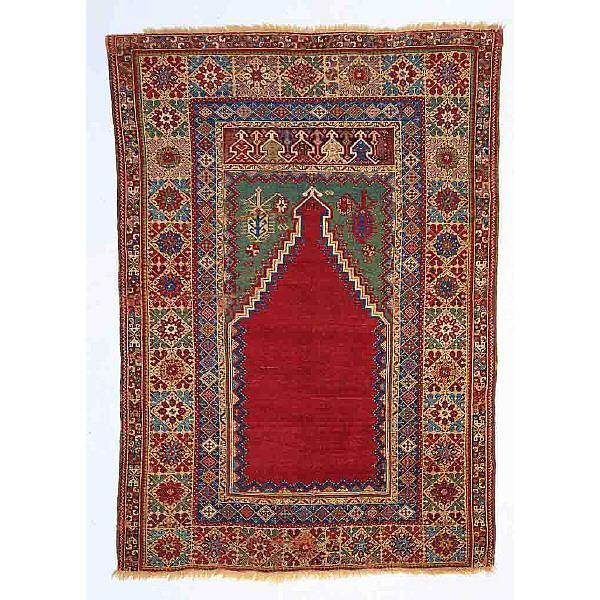Attending a museum exhibition is always an educative experience. You can obtain new knowledge or discover new areas of interest. However, the most astounding thing about going to museums is the way you feel after the end of the excursion. You never leave the same because you start drawing lines connecting you to what you have just seen and somehow feel yourself a part of a broader culture and period in history. At least, it is what always happens to me when I go to museums.
This time, we were requested to attend the Saint Louis Art Museum and choose one piece of art to reflect on. Being a Muslim, what initially caught my attention was a prayer carpet displayed as a part of the Islamic Art exhibition portraying the traditions of Islam of different cultures and periods from Ottoman to Persian and Indian cultures. The show collected bowls, jars, daggers, dishes, bottles, doorknockers, carpets and rugs, ewers, floor spreads, helmets, door covers, mosaic panels, tiles, shields, swords, and numerous other attributes of the Islamic culture. The showpiece I have chosen was one of the prayer carpets that drew my attention because of its bright colors and intricate ornamental design.
The piece of art that caught my eye was a prayer rug (saccade) of the Ottoman period covering years 1281-1924 (Shoup 300). My item of display dated back to the early 19th century (see picture below). It was made from wool in Mujur District, Konya Province, Central Antaolia in Turkey. Museum inherited it from the collection of oriental rugs of James F. Ballard, an American entrepreneur and a collector of oriental rugs from the Middle East and Asia (Erdmann 89). This prayer rug comes from the period when weaving prayer carpets has become commercialized in the Antaolian region. That is why it has intricate designs, which were developed specifically for people coming to the Middle East from the Western world (Bloom and Blair 371). It was made up in a manner traditional for small villages of this Turkish territory. Seccade, by the way, is the Turkish word standing for a small prayer rug.

The chosen piece of art is an example of classic weaving. It is the representation of Islamic traditions with borders designed with intricate ornaments and a single stepped arch located in the center of the carpet. The green areas above the arch point to ritual ablutions. They demonstrate the religious requirement to wash face, hands, and feet before the prayer because Muslims are obliged to clean up before each of the five daily prayers.
It is the portrayal of the connection with religion because it is an inseparable attribute of Islam. Prayer rugs were often made up of the best quality materials available and they were granted as gifts to mosques. Moreover, they were always protected under religious endowments because they were considered to be the sanctuary. Because they were expensive and often seen as pieces of luxury, in most cases, prayer rugs were believed to be the attributes of holy people dividing them from mundane issues and serving as protection and a platform for performing prayers. It was even believed that prayer rug could be used for prayers in the air or on the ocean waves thus hinting to the supernatural powers of the holy people and the intensity of faith (Jestice 410). The chosen rug is harmonious in colors. Even though there are contrasting elements of green and red, it is the peculiarity of the Turkish tradition of weaving prayer rugs (Breck and Morris xxi). There is a hint to floral design in the border that was also specific for Antaolian traditions. The green elements of the rug are the reminders of the ritual ablutions because they symbolize water and cleanness.
The reason why this prayer rug caught my attention is, first of all, because I am a Muslim. Second, I liked the colors and looking at it, I somehow felt myself in 19th century Turkey, looking at the people dwelling in small villages and weaving them. It made me feel the traditions of both Islamic culture and local peculiarities interwoven with the desire to become closer to Western culture. It prompted me to reflect on the ways our lives changed in some two hundred years. I have never really thought that the rugs of such beauty were once considered pieces of luxury and that it cost much to have one. What today is a part of the routine and easily accessible, once was hard to possess. Moreover, I felt happiness for myself because even in modern society, there is still room for the sanctuary things, seeking connection with religion and showing respect to Islamic traditions. Of course, I might not believe that a prayer rug is an attribute of a holy person, but I still have it and do not rush to forget about my traditions but desire to preserve them.
Works Cited
Bloom, Jonathan, and Shella S. Blair. The Groove Encyclopedia of Islamic Art and Architecture. Oxford, New York: Oxford University Press, 2009. Print.
Breck, Joseph, and France Morris. The James F. Ballard Collection of Oriental Rugs. New York, New York: The Metropolitan Art Museum, 1923. Print.
Erdmann, Kurt. Seven Hundred Years of Oriental Carpets. Berkeley, California: University of California Press, 1970. Print.
Jestice, Phyllip G. Holy people of the World: A Cross-Cultural Encyclopedia. Santa Barbara, California: ABC Clio, 2011. Print.
“Prayer Carpet (Seccade)” n.d. JPEG File. Web.
Shoup, John A. Ethnic Groups of Africa and the Middle East: An Encyclopedia. Santa Barbara, California: ABC Clio, 2011. Print.